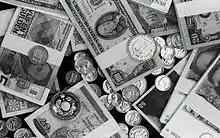Store of value
A store of value is the function of an asset that can be saved, retrieved and exchanged at a later time, and be predictably useful when retrieved. More generally, a store of value is anything that retains purchasing power into the future.
The most common store of value in modern times has been money, currency, or a commodity like a precious metal or financial capital. The point of any store of value is risk management due to a stable demand for the underlying asset. Money is one of the best stores of value because of its liquidity, that is, it can easily be exchanged for other goods and services.[1] An individual's wealth is the total of all stores of value including both monetary and nonmonetary assets.[2]
Money as a store of value

Monetary economics is the branch of economics which analyses the functions of money. Storage of value is one of the three generally accepted functions of money.[2] The other functions are the medium of exchange, which is used as an intermediary to avoid the inconveniences of the coincidence of wants, and the unit of account, which allows the value of various goods, services, assets and liabilities to be rendered in multiples of the same unit. Money is well-suited to storing value because of its purchasing power.[1] It is also useful because of its durability.[3]
Because of its function as a store of value, large quantities of money are hoarded.[4] Money's usefulness as a store of value declines if there are significant changes in the general level of prices.[5] So if inflation rises, purchasing power declines and a cost is placed on those holding money.[6]
Workers who are paid in a currency which is experiencing high-inflation will prefer to spend their income quickly instead of saving it.[3] When a currency loses its store of value, or more accurately when a currency is perceived to lose its future purchasing power, it fails to function as money. This causes people to use currencies from other countries as a substitute.[3]
According to the Cambridge cash-balance theory, which is represented by the Cambridge equation, money's ability to store value is more important than its function as a medium of exchange.[7] Cambridge claims that the demand for money is derived from its ability to store value. This is contrary to Fisher economists' belief that demand arises because money is needed for exchange.[8]
Other stores of value


Examples for stores of value other than money are:
- Bonds - value is guaranteed by a legal contract
- Collectibles, e.g. original art by a famous artist or antiques such as ancient artifacts or ancient coinage
- Gemstones
- Gift economy relationships – value is stored as social reputation
- Labor notes (currency)
- Livestock ownership and control (see African currency)
- Fine wine
- Precious metals – ownership in gold, silver, platinum, and palladium
- Real estate – ownership in actual deeds in protectable controllable land
- Stored-value cards – value is physically stored on the cards in the form of binary coded data
While these items may be inconvenient to trade daily or store, and may vary in value quite significantly, they rarely lose all value. It need not be a capital asset at all, merely have economic value that is not known to disappear even in the worst situation. The disadvantage for land, houses and property as a store for value is that it may take time to find a buyer for those assets.[6] In principle, this could be true of any industrial commodity, but gold and precious metals are generally favored, because of their demand and rarity in nature, which reduces the risk of devaluation associated with increased production and supply.
Speculative investments
Insofar as an investment is speculative, it should not be considered a store of value because it lacks stability. An asset should only be considered a store of value if it is stable against future purchasing power.
At various times throughout history, people and nations have famously made the mistake of believing that they could "store value" in speculative instruments, misunderstanding that ones personal choice to invest in a speculative asset does not automatically convert that asset into a proper and predictable store of value.
Examples of assets that are not traditionally considered stores of value:
- Stocks – A share of ownership of a publicly-traded company
- Cryptocurrencies – digital currencies
See also
References
- Gwartney, James; Richard Stroup; Russell Sobel; David Macpherson (2008). Economics: Private and Public Choice. Cengage Learning. p. 264. ISBN 978-0324580181. Retrieved 2 January 2017.
- Mankiw, N. Gregory (2012). Essentials of Economics. Cengage Learning. p. 437. ISBN 978-1133418948. Retrieved 2 January 2017.
- Boyes, William; Michael Melvin (2011). Fundamentals of Economics. Cengage Learning. p. 295. ISBN 978-1133172994. Retrieved 3 January 2017.
- Einzig, Paul (2014). Primitive Money: In its Ethnological, Historical and Economic Aspects, Edition 2. Elsevier. p. 425. ISBN 9781483157153. Retrieved 3 January 2017.
- Currie, David A. (1981). Macro Economic Analysis. Nirali Prakashan. p. 2.14. ISBN 9380064195. Retrieved 3 January 2017.
- Gwartney, James; Richard Stroup; Russell Sobel; David Macpherson (2008). Macroeconomics: Public and Private Choice. Cengage Learning. p. 264. ISBN 978-0324580198. Retrieved 3 January 2017.
- Economic Concepts and Methods. FK Publications. p. 297. ISBN 818859718X. Retrieved 4 January 2017.
- Reddy, R. Jayaprakash (2004). Advanced Monitory Theory & Policies. APH Publishing. p. 50. ISBN 8176486124. Retrieved 4 January 2017.
External links
- Wiens, Elmer G. (2005). "Linguistic and Commodity Exchanges". First Nations Studies.
Examines the structural differences between barter and monetary commodity exchanges and oral and written linguistic exchanges